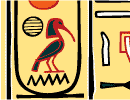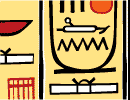The Temple of Re-Harakhte
(The Sun Temple of Ramesses II)
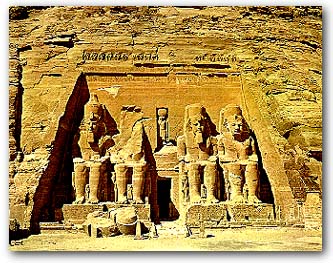 The main temple was dedicated to Ramesses II and to the four universal gods Ptah,
Re-Harakhte, Amun-Re, and to Ramesses II himself. Of the seven temples he built, Abu
Simbel is considered to be the most impressive. The main temple was dedicated to Ramesses II and to the four universal gods Ptah,
Re-Harakhte, Amun-Re, and to Ramesses II himself. Of the seven temples he built, Abu
Simbel is considered to be the most impressive.
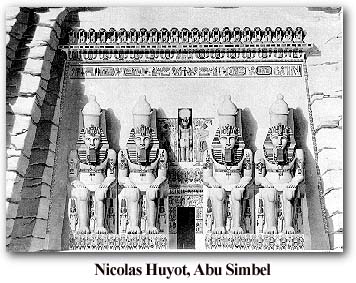 The facade of the main temple is
108 feet high and 125 feet wide
with four colossal seated statues
about 65 feet high wearing the
double crown and having the
cartouches of Ramesses II. They
are taller than the colossi of
Memnon at Thebes and are
carved out of solid rock. At the
feet of the calossus, beginning on
the left are Queen Nofretari,
Prince Amenhirkhopshef, the
Kings mother Muttuya, Princess
Bent'anta, unnamed, but probably
Esenofre, Princess Nebettawy,
Queen Muttuya, Princess Nofretari, Princess Merytamun, Princess Beketmut, Prince
Ri'amsese, and Queen Nofretari, who where all members of Ramesses II's family. (Editor's
Note: We wonder if Ramesses II bribed his kids to make good grades. Bring home an A and
I'll put you in my new Colossus.) The facade of the main temple is
108 feet high and 125 feet wide
with four colossal seated statues
about 65 feet high wearing the
double crown and having the
cartouches of Ramesses II. They
are taller than the colossi of
Memnon at Thebes and are
carved out of solid rock. At the
feet of the calossus, beginning on
the left are Queen Nofretari,
Prince Amenhirkhopshef, the
Kings mother Muttuya, Princess
Bent'anta, unnamed, but probably
Esenofre, Princess Nebettawy,
Queen Muttuya, Princess Nofretari, Princess Merytamun, Princess Beketmut, Prince
Ri'amsese, and Queen Nofretari, who where all members of Ramesses II's family. (Editor's
Note: We wonder if Ramesses II bribed his kids to make good grades. Bring home an A and
I'll put you in my new Colossus.)
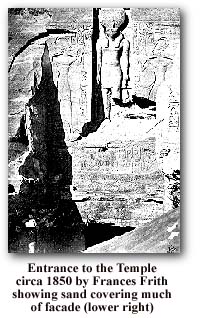 Above the doorway in a niche stands the sun god, a falcon headed representation of
Ramesses, holding a war-scepter which shows the head and neck of an animal which is read
as user, in his right and a figure of Ma'at in his left. This cleverly creates the Kings throne name
of User-Ma'at-Re. At the top of the facade is a row of baboons which are thought to be
greeting the morning sun and indeed the monument looks best at that time. The sides of the
thrones next to the entrance are decorated with Nile gods symbolically uniting Egypt, while
below are prisoners, representing conquered nations, to the left, African and to the right,
Asian. Above the doorway in a niche stands the sun god, a falcon headed representation of
Ramesses, holding a war-scepter which shows the head and neck of an animal which is read
as user, in his right and a figure of Ma'at in his left. This cleverly creates the Kings throne name
of User-Ma'at-Re. At the top of the facade is a row of baboons which are thought to be
greeting the morning sun and indeed the monument looks best at that time. The sides of the
thrones next to the entrance are decorated with Nile gods symbolically uniting Egypt, while
below are prisoners, representing conquered nations, to the left, African and to the right,
Asian.
The entrance leads into a Grand Hall which is 57 feet high and 52 feet wide and was cut from
the rock. It is supported with eight pillars with statues of Ramesses. The statues on the north
side of the hall wear the double crown, while those on the south the white crown of upper
Egypt. Just as other temples in Egypt, the floor and ceiling taper off to draw focus to the
sanctuaries in the back of the temple. The reliefs on the north wall of the Grand Hall show
scenes from the Battle of Kadesh. Other walls depict the king slaughtering captives in front of
the gods Amun-Re and Re-Harakhte, and storming a fortress with his three sons.
To either side of the Grand Hall are smaller rooms, two to the South and four to the North.
Most suggest that these rooms were for storage (treasure rooms) but elsewhere it is suggested
that they were used for festivals related to the Kings Jubilee.
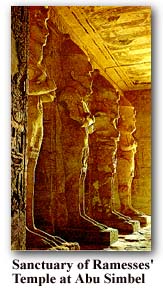 Beyond the Grand Hall is the second hypostyle hall with its
flowered pillars. Scenes in this hall show the King and his wife,
Nefertari making offerings to Amun and Re-Harakhte (the Sun
God), and beyond that is the three chapels, the central one
containing the four deities worshipped in the temple (including
Ramesses II). A Solstices occurs twice a year on or about
February 20-22nd and October 20-22nd when the rays from the
sun enter the front of the temple and bathe the statues of the Gods
200 feet inside the temple with light. Interestingly enough, all but
Ptah, the source of Chthonian life. Beyond the Grand Hall is the second hypostyle hall with its
flowered pillars. Scenes in this hall show the King and his wife,
Nefertari making offerings to Amun and Re-Harakhte (the Sun
God), and beyond that is the three chapels, the central one
containing the four deities worshipped in the temple (including
Ramesses II). A Solstices occurs twice a year on or about
February 20-22nd and October 20-22nd when the rays from the
sun enter the front of the temple and bathe the statues of the Gods
200 feet inside the temple with light. Interestingly enough, all but
Ptah, the source of Chthonian life.
On either side of the Facade are two small chapels. At the
Southeast corner of the facade there are three stelae. One of these
is called the Marriage Stela and documents the marriage of
Ramesses II to the daughter of the King of the Hittites. (Editors
Note: The question is, what did she look like? Did Ramesses
consider this a heroic deed?) On the other side of the Facade is the Sun Chapel, an open
court dedicated to the sun. Here, there are pillars with cavetto cornices. The one with steps
held four praying baboons, the other a chapel with images of Khepri and Baboon-Thoth. The
latter is now in the Antiquities Museum in Cairo.
|
